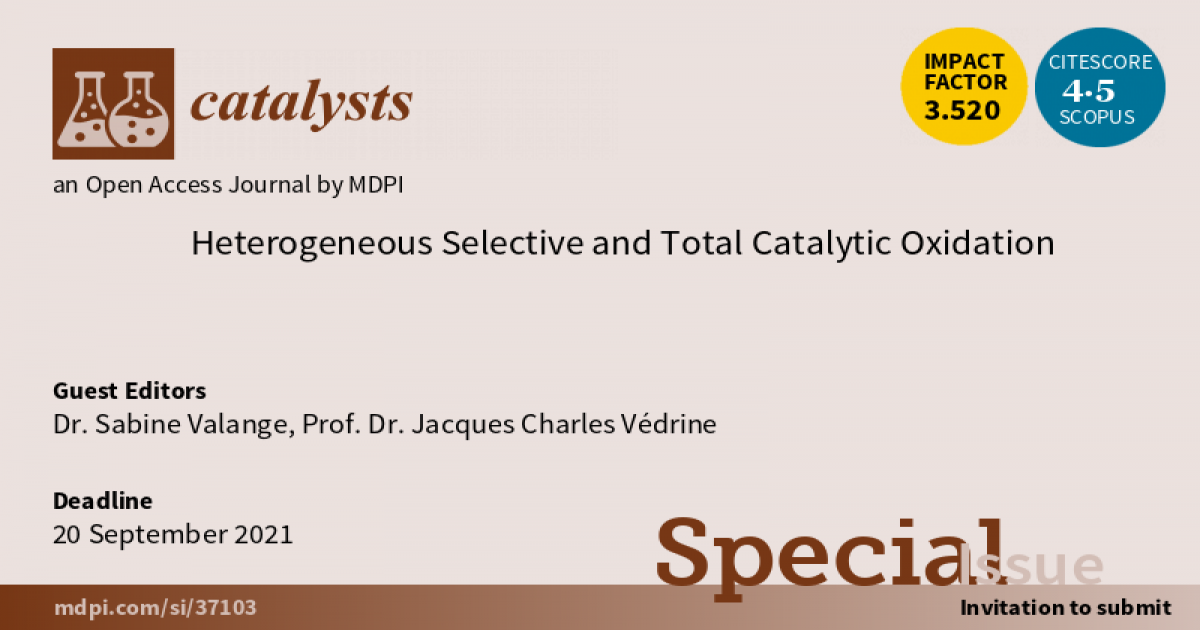Heterogeneous Selective and Total Catalytic Oxidation
A special issue of Catalysts (ISSN 2073-4344). This special issue belongs to the section "Environmental Catalysis".
Deadline for manuscript submissions: closed (30 April 2022) | Viewed by 34858

Special Issue Editors
Interests: catalyst synthesis; porous materials; nanostructured oxides; heterogeneous catalysis; selective oxidation; total oxidation; biomass valorization; ball-milling; ultrasound; sonochemistry; sonocatalysis; sustainable chemistry
Special Issues, Collections and Topics in MDPI journals
Interests: heterogeneous catalysis (acid–base and selective oxidation reactions); physical techniques of characterization; metal oxide catalysts; zeolites and porous materials; heterpolyoxometallates
Special Issues, Collections and Topics in MDPI journals
Special Issue Information
Dear Colleagues,
Heterogeneous catalytic oxidation is a vital key enabling technology for the production of value-added organic chemicals, as well as for depollution/remediation purposes. Most industrial processes involve selective (partial) and total oxidation reactions in either gas or liquid phase. For instance, the selective oxidation of alcohols to carbonyl compounds (e.g., aldehydes, ketones, carboxylic acids, esters) is a key domain for industry, as well as those reactions leading to olefins from alkanes or aldehydes, carboxylic acids, and nitriles from olefins or alkanes. The abatement of organic pollutants for clean air or water purification/treatment also covers a large part of the heterogeneous catalytic oxidation reactions. This includes atmospheric pollutants such as volatile organic compounds (VOCs), NH3, CO, CH4, etc., and a variety of organic pollutants in liquid phase, such as dyes, phenols, pesticides, pharmaceuticals, and personal care products.
Selective and total catalytic oxidation reactions offer many advantages, but there is still a need for catalysts with improved performance. In both cases, the control of the selectivity to the desired product is the major challenge to be overcome. Additionally, with the increased environmental issues and legislation constraints, energy-efficient heterogeneous catalytic oxidation processes have to be promoted for a more sustainable world. In this respect, physical activation methods based on, for instance, ultrasound and microwave irradiations, ball milling (reactive grinding), non-thermal plasma, electrochemical and photo-activated processes, and their combination, are viewed as sustainable approaches to increase reaction rates and shorten reaction times while enhancing yields and selectivities.
Based on the above considerations, submissions to this Special Issue are welcome in the form of original research papers, reviews, or communications that highlight promising recent research and novel trends in the field of heterogeneous catalytic oxidation or photocatalytic oxidation. Both selective and total oxidation reactions will be considered in this themed issue. They could either encompass the (photo)catalytic transformation of various organic compounds (alcohols, alkanes, alkenes, bio-derived sustainable feedstocks, lignocellulosic biomass, waste, etc.) to value-added chemicals or the (photo)catalytic removal/degradation of organic pollutants (dyes, aromatics, pesticides, pharmaceuticals, VOCs, CO, CH4, etc.). Reactions could be in liquid or gas phase, employing a variety of nanocatalysts (metal oxides, metals or organometallic complexes supported or not on inert oxides or (porous)carbons; zeolites; mesoporous materials) and various oxidants (O2, H2O2, O3, oxone, peroxydisulfate, etc.). The topic also concerns the development of new catalysts’ synthetic routes for the abovementioned (photo)catalytic reactions, as well as the establishment of structure–property relationships for the understanding of the reaction mechanisms. Moreover, studies dealing with the use of physical activation methods (e.g., ultrasound, microwave, ball-milling, non-thermal plasma, UV, electrochemistry) either for selective and total catalytic oxidation reactions or for the design of nanomaterials with improved characteristics and catalytic properties in view of the topic of this Special Issue are also very welcome. Both academic and industrial research studies are perfectly matched to this Special Issue dedicated to Heterogeneous Selective and Total Catalytic Oxidation.
Prof. Dr. Sabine ValangeProf. Dr. Jacques Charles Védrine
Guest Editor
Manuscript Submission Information
Manuscripts should be submitted online at www.mdpi.com by registering and logging in to this website. Once you are registered, click here to go to the submission form. Manuscripts can be submitted until the deadline. All submissions that pass pre-check are peer-reviewed. Accepted papers will be published continuously in the journal (as soon as accepted) and will be listed together on the special issue website. Research articles, review articles as well as short communications are invited. For planned papers, a title and short abstract (about 100 words) can be sent to the Editorial Office for announcement on this website.
Submitted manuscripts should not have been published previously, nor be under consideration for publication elsewhere (except conference proceedings papers). All manuscripts are thoroughly refereed through a single-blind peer-review process. A guide for authors and other relevant information for submission of manuscripts is available on the Instructions for Authors page. Catalysts is an international peer-reviewed open access monthly journal published by MDPI.
Please visit the Instructions for Authors page before submitting a manuscript. The Article Processing Charge (APC) for publication in this open access journal is 2700 CHF (Swiss Francs). Submitted papers should be well formatted and use good English. Authors may use MDPI's English editing service prior to publication or during author revisions.
Keywords
- heterogeneous catalysis
- partial/selective oxidation
- total oxidation
- photocatalysis
- liquid and gas phase
- supported and unsupported catalysts (metal oxides, metals, organometallic complexes, nanocatalysts, zeolites, mesoporous materials, photocatalysts)
- physical activation methods (e.g. ultrasound, microwave, ball-milling, non-thermal plasma, UV, electrochemistry)
- water and air treatment
- AOP (advanced oxidation process)






